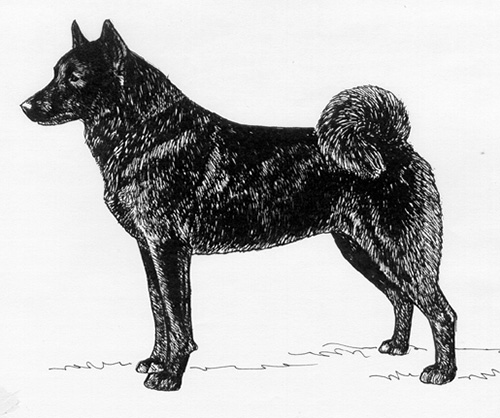Russian-European Laika
Northern Breed Group
The goals and purposes of this breed standard include: to furnish guidelines for breeders who wish to maintain the quality of their breed and to improve it; to advance this breed to a state of similarity throughout the world; and to act as a guide for judges.
Breeders and judges have the responsibility to avoid any conditions or exaggerations that are detrimental to the health, welfare, essence and soundness of this breed, and must take the responsibility to see that these are not perpetuated.
Any departure from the following should be considered a fault, and the seriousness with which the fault should be regarded should be in exact proportion to its degree and its effect upon the health and welfare of the dog and on the dog’s ability to perform its traditional work.
History
The Russian-European Laika originated in the northern zone of the European part of Russia, between Finland and the Uralian mountains. It is the smallest of the three Laika breeds, and is used as an all around hunting dog on both large and small game, though it was originally used mainly to hunt squirrel. It is closely related to the Karelian Bear Dog, but is smaller, lighter in bone and squarer in build.
The Russian-European Laika was recognized by the United Kennel Club January 1, 1996.
General Appearance
The Russian-European Laika is a medium size, slightly rectangular, strong, dry, agile dog. It has a moderate length, hard, double coat that is either black or dark grey with white, prick ears and small, slanting eyes.
Characteristics
Friendly, affectionate and loyal, extremely tolerant of children. The breed is strongly territorial and may be aggressive towards dogs that invade its territory. The Russian-European Laika has a very strongly developed hunting instinct and a good sense of direction. They are very efficient at trailing and treeing game such as squirrels and marten and bay at the game once it is treed. They may also be used on large game such as bear and moose.
Head
The head is relatively small.
SKULL
The skull is shaped like an equilateral triangle.
MUZZLE
The muzzle is dry, strong and tapering.
TEETH
The Russian-European Laika has a complete set of evenly spaced, white teeth meeting in a scissors bite.
NOSE
Black.
EYES
Small, oval in shape, slanting, and dark in color.
EARS
Prick, pointed at the tips, and very mobile.
Neck
Muscular and dry, about the same length as the head.
Forequarters
Well-angulated between the shoulder blade and upper arm.
FORELEGS
Straight, with medium length, flexible pasterns.
Body
Just slightly longer than tall in proportion, measured from the withers to the ground and the breastbone to the buttocks. The chest is deep and well-developed. The back is strong and muscular, and the loin is short and slightly arched. The croup is broad, short and slightly sloping. There is a marked tuck-up.
Hindquarters
The hindquarters are strong and well angulated.
HIND LEGS
The thighs are long and muscular. There is good angulation at the hock joint. Rear dewclaws should be removed.
Feet
The feet are oval, with strong, tight toes.
Tail
The tail is either sickle or ringed, carried over the back or buttocks.
Coat
Harsh and straight, with a well-developed undercoat. The coat on the face and ears is short and close fitting. It is longer on the neck, withers and shoulders, forming a beard on the cheekbones and a stand-off collar on the neck. The fronts of the legs are covered with short, smooth hair. On the back of the legs the hair is longer, but there is no feathering.
Color
Black, grey or salt and pepper, with white markings. Either predominately colored with white patches or predominately white with colored patches. Heavy ticking on the legs or red color is undesirable.
Height
Height for males is 20.5 to 23 inches. For females, it is 19.5 to 22 inches.
Gait
The typical gait for the breed is a gallop, alternating with a short trot.
Disqualifications
(A dog with a Disqualification must not be considered for placement in a conformation event, and must be reported to UKC.)
Unilateral or bilateral cryptorchid.
Viciousness or extreme shyness.
Albinism.

Looking for a Dog?
Find a dog that will fit your family.
Note: The breeders on this list are not endorsed by UKC.
©Copyright 1996, United Kennel Club
